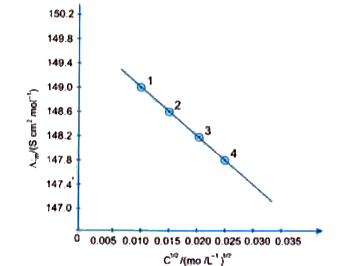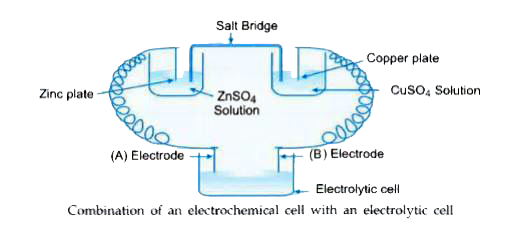CASE BASED/SOURCE-BASED INTEGRATED QUESTIONS (TRUE OR FALSE ) from U-LIKE CHEMISTRY (HINGLISH) ELECTROCHEMISTRY for Class 12
| Class 12 | CHEMISTRY |
| Chapter | ELECTROCHEMISTRY |
| U-LIKE CHEMISTRY (HINGLISH) | CASE BASED/SOURCE-BASED INTEGRATED QUESTIONS (TRUE OR FALSE ) |
| Medium | English |
| Academic Year | 2023-2024 |
Question 1
Read the given passage and answer the questions number that follow :
We know that accurate measurement of an unknown resistance can be performed on a Wheatstone bridge: However, for measuring the resistance of an ionic solution we face two problems. Firstly, passing direct current (DC) changes the composition of the solution. Secondly, a solution cannot be connected to the bridge like a metallic wire or other solid conductor. The first difficulty is resolved by using an alternating current (AC) source of power. The second problem is solved by using a specially designed vessel called conductivity cell. Basically it consists of two platinum electrodes coated with platinum black (finely divided metallic Pt is deposited on the electrodes electrochemically). These have area of cross-section equal to 'A' and are separated by distance 'l'. Therefore, solution confined between these electrodes is a column of length 'l' and area of cross-section 'A'. The resistance of such a column of solution is given by the equation :
R=ρ1A=1kA
Name the instrument for accurate measurement of an unknown resistance.View SolutionQuestion 2
Read the given passage and answer the questions number that follow :
We know that accurate measurement of an unknown resistance can be performed on a Wheatstone bridge: However, for measuring the resistance of an ionic solution we face two problems. Firstly, passing direct current (DC) changes the composition of the solution. Secondly, a solution cannot be connected to the bridge like a metallic wire or other solid conductor. The first difficulty is resolved by using an alternating current (AC) source of power. The second problem is solved by using a specially designed vessel called conductivity cell. Basically it consists of two platinum electrodes coated with platinum black (finely divided metallic Pt is deposited on the electrodes electrochemically). These have area of cross-section equal to 'A' and are separated by distance 'l'. Therefore, solution confined between these electrodes is a column of length 'l' and area of cross-section 'A'. The resistance of such a column of solution is given by the equation :
R=ρ1A=1kA
Why can't we use direct current for this measurement ? View SolutionQuestion 3
Read the given passage and answer the questions number that follow :
We know that accurate measurement of an unknown resistance can be performed on a Wheatstone bridge: However, for measuring the resistance of an ionic solution we face two problems. Firstly, passing direct current (DC) changes the composition of the solution. Secondly, a solution cannot be connected to the bridge like a metallic wire or other solid conductor. The first difficulty is resolved by using an alternating current (AC) source of power. The second problem is solved by using a specially designed vessel called conductivity cell. Basically it consists of two platinum electrodes coated with platinum black (finely divided metallic Pt is deposited on the electrodes electrochemically). These have area of cross-section equal to 'A' and are separated by distance 'l'. Therefore, solution confined between these electrodes is a column of length 'l' and area of cross-section 'A'. The resistance of such a column of solution is given by the equation :
R=ρ1A=1kA
Where do we take the solution for the measurement of conductivity ?View SolutionQuestion 4
Read the given passage and answer the questions number that follow :
We know that accurate measurement of an unknown resistance can be performed on a Wheatstone bridge: However, for measuring the resistance of an ionic solution we face two problems. Firstly, passing direct current (DC) changes the composition of the solution. Secondly, a solution cannot be connected to the bridge like a metallic wire or other solid conductor. The first difficulty is resolved by using an alternating current (AC) source of power. The second problem is solved by using a specially designed vessel called conductivity cell. Basically it consists of two platinum electrodes coated with platinum black (finely divided metallic Pt is deposited on the electrodes electrochemically). These have area of cross-section equal to 'A' and are separated by distance 'l'. Therefore, solution confined between these electrodes is a column of length 'l' and area of cross-section 'A'. The resistance of such a column of solution is given by the equation :
R=ρ1A=1kA
The electrical resistance of a column of 0.05 mol L NaOH solution of diameter 1 cm and length 50 cm is 5.55 x 108 ohm. Calculate its resistivity. View SolutionQuestion 5
Read the given passage and answer the questions number that follow :
We know that accurate measurement of an unknown resistance can be performed on a Wheatstone bridge: However, for measuring the resistance of an ionic solution we face two problems. Firstly, passing direct current (DC) changes the composition of the solution. Secondly, a solution cannot be connected to the bridge like a metallic wire or other solid conductor. The first difficulty is resolved by using an alternating current (AC) source of power. The second problem is solved by using a specially designed vessel called conductivity cell. Basically it consists of two platinum electrodes coated with platinum black (finely divided metallic Pt is deposited on the electrodes electrochemically). These have area of cross-section equal to 'A' and are separated by distance 'l'. Therefore, solution confined between these electrodes is a column of length 'l' and area of cross-section 'A'. The resistance of such a column of solution is given by the equation :
R=ρ1A=1kA
If the distance between the electrodes and area of cross-section of a cell are 2.5 cm and 6.75 cm2 respectively. Calculate the cell constant. View SolutionQuestion 6
Read the given passage and answer the questions number that follow :
Molar conductivity increases with decrease in concentration. This is because the total volume, V, of solution containing one mole of electrolyte also increases. It has been found that decrease in K on dilution of a solution is more than compensated by increase in its volume. Physically, it means that at a given concentration, Am can be defined as the conductance of the electrolytic solution kept between the electrodes of a conductivity cell at unit distance but having area of cross-section large enough to accommodate sufficient volume of solution that contains one mole of the electrolyte. When concentration approaches zero, the molar conductivity is known as limiting molar conductivity and is represented by the symbol Am The variation in Λm with concentration is different for strong and weak electrolytes.
Why does molar conductivity increase with decrease in concentration ? View SolutionQuestion 7
Read the given passage and answer the questions number that follow :
Molar conductivity increases with decrease in concentration. This is because the total volume, V, of solution containing one mole of electrolyte also increases. It has been found that decrease in K on dilution of a solution is more than compensated by increase in its volume. Physically, it means that at a given concentration, Am can be defined as the conductance of the electrolytic solution kept between the electrodes of a conductivity cell at unit distance but having area of cross-section large enough to accommodate sufficient volume of solution that contains one mole of the electrolyte. When concentration approaches zero, the molar conductivity is known as limiting molar conductivity and is represented by the symbol Am The variation in Λm with concentration is different for strong and weak electrolytes.
Define Λm at a given concentration.View SolutionQuestion 8
Read the given passage and answer the questions number that follow :
Molar conductivity increases with decrease in concentration. This is because the total volume, V, of solution containing one mole of electrolyte also increases. It has been found that decrease in K on dilution of a solution is more than compensated by increase in its volume. Physically, it means that at a given concentration, Am can be defined as the conductance of the electrolytic solution kept between the electrodes of a conductivity cell at unit distance but having area of cross-section large enough to accommodate sufficient volume of solution that contains one mole of the electrolyte. When concentration approaches zero, the molar conductivity is known as limiting molar conductivity and is represented by the symbol Λm The variation in Am with concentration is different for strong and weak electrolytes.
Why is meant by limiting molar conductivity ?View SolutionQuestion 9
Read the given passage and answer the questions number that follow :
Molar conductivity increases with decrease in concentration. This is because the total volume, V, of solution containing one mole of electrolyte also increases. It has been found that decrease in K on dilution of a solution is more than compensated by increase in its volume. Physically, it means that at a given concentration, Am can be defined as the conductance of the electrolytic solution kept between the electrodes of a conductivity cell at unit distance but having area of cross-section large enough to accommodate sufficient volume of solution that contains one mole of the electrolyte. When concentration approaches zero, the molar conductivity is known as limiting molar conductivity and is represented by the symbol Λm The variation in Am with concentration is different for strong and weak electrolytes.
How is limiting molar conductivity represented ?View SolutionQuestion 10
Read the given passage and answer the questions number that follow :
Molar conductivity increases with decrease in concentration. This is because the total volume, V, of solution containing one mole of electrolyte also increases. It has been found that decrease in K on dilution of a solution is more than compensated by increase in its volume. Physically, it means that at a given concentration, Am can be defined as the conductance of the electrolytic solution kept between the electrodes of a conductivity cell at unit distance but having area of cross-section large enough to accommodate sufficient volume of solution that contains one mole of the electrolyte. When concentration approaches zero, the molar conductivity is known as limiting molar conductivity and is represented by the symbol Λm The variation in Am with concentration is different for strong and weak electrolytes.
Is the variation in Λm with concentration same or different for weak and strong electrolytes ?View SolutionQuestion 11
Read the given passage and answer the questions number that follow :
Weak electrolytes like acetic acid have lower degree of dissociation at higher concentrations and hence for such electrolytes, the change in Λm with dilution is due to increase in the degree of dissociation and consequently the number of ions in total volume of solution that contains one mol of electrolyte. In such cases Λm increases steeply on dilution, especially near lower concentrations. Therefore, Λm cannot be obtained by extrapolation of Λm to zero concentration. At infinite dilution (i.e., concentration c → zero) electrolyte dissociates completely (α = 1), but at such low concentration the conductivity of the solution is so low that it cannot be measured accurately. Therefore, Λ∘m for weak electrolytes is obtained by using Kohlrausch law of independence migration of ions.
Why does the change in Am take place on dilution in case of weak electrolytes ?View SolutionQuestion 12
Read the given passage and answer the questions number that follow :
Weak electrolytes like acetic acid have lower degree of dissociation at higher concentrations and hence for such electrolytes, the change in Λm with dilution is due to increase in the degree of dissociation and consequently the number of ions in total volume of solution that contains one mol of electrolyte. In such cases Λm increases steeply on dilution, especially near lower concentrations. Therefore, Λm cannot be obtained by extrapolation of Λm to zero concentration. At infinite dilution (i.e., concentration c → zero) electrolyte dissociates completely (α = 1), but at such low concentration the conductivity of the solution is so low that it cannot be measured accurately. Therefore, Λ∘m for weak electrolytes is obtained by using Kohlrausch law of independence migration of ions.
Why does the change in Λm take place on dilution in case of weak electrolytes ?View SolutionQuestion 13
Read the given passage and answer the questions number that follow :
Weak electrolytes like acetic acid have lower degree of dissociation at higher concentrations and hence for such electrolytes, the change in Λm with dilution is due to increase in the degree of dissociation and consequently the number of ions in total volume of solution that contains one mol of electrolyte. In such cases Λm increases steeply on dilution, especially near lower concentrations. Therefore, Λm cannot be obtained by extrapolation of Λm to zero concentration. At infinite dilution (i.e., concentration c → zero) electrolyte dissociates completely (α = 1), but at such low concentration the conductivity of the solution is so low that it cannot be measured accurately. Therefore, Λ∘m for weak electrolytes is obtained by using Kohlrausch law of independence migration of ions.
Why can't we obtain Λ∘m by extrapolation of Λm to zero concentration ?View SolutionQuestion 14
Read the given passage and answer the questions number that follow :
Weak electrolytes like acetic acid have lower degree of dissociation at higher concentrations and hence for such electrolytes, the change in Λm with dilution is due to increase in the degree of dissociation and consequently the number of ions in total volume of solution that contains one mol of electrolyte. In such cases Λm increases steeply on dilution, especially near lower concentrations. Therefore, Λm cannot be obtained by extrapolation of Λm to zero concentration. At infinite dilution (i.e., concentration c → zero) electrolyte dissociates completely (α = 1), but at such low concentration the conductivity of the solution is so low that it cannot be measured accurately. Therefore, Λ∘m for weak electrolytes is obtained by using Kohlrausch law of independence migration of ions.
Which law is used lo calculate Λ∘m for weak electrolyles ?View SolutionQuestion 15
Read the given passage and answer the questions number that follow :
Weak electrolytes like acetic acid have lower degree of dissociation at higher concentrations and hence for such electrolytes, the change in Λm with dilution is due to increase in the degree of dissociation and consequently the number of ions in total volume of solution that contains one mol of electrolyte. In such cases Λm increases steeply on dilution, especially near lower concentrations. Therefore, Λm cannot be obtained by extrapolation of Λm to zero concentration. At infinite dilution (i.e., concentration c → zero) electrolyte dissociates completely (α = 1), but at such low concentration the conductivity of the solution is so low that it cannot be measured accurately. Therefore, Λ∘m for weak electrolytes is obtained by using Kohlrausch law of independence migration of ions.
Give the mathematical relation to calculate the degree of dissociation, α for a weak electrolyte.View SolutionQuestion 39
Assertion (A) : At equilibrium, there is a separation of charges and depending upon the tendencies of two opposing reactions, the electrode may be positively or negatively charged with respect to the solution.
Reason (R) : At each electrode-electrolyte interface, there is a tendency of the metal ions from the solution to deposit on the metal and metal atoms of the electrode to go into the solution leaving behind electrons on the electrode.View SolutionQuestion 43
Assertion (A): If the standard reduction potential of an electrode is greater than zero, then its reduced form is less stable compared to hydrogen gas.
Reason (R) : Standard hydrogen electrode represented by Pt(s)|H2(g)|H+(aq) is assigned a zero potential at all temperatures. View SolutionQuestion 115
From the given cells : Lead storage cell, Mercury cell, Fuel cell and Dry cell Answer the following:
(i) Which cell is used in hearing aids ?
(ii) Which cell was used in Apollo Space Programme ?
(iii) Which cell is used in automobiles and inverters ?
(iv) Which cell does not have long life ?View SolutionQuestion 116
(a) Following reactions occur at cathode during the electrolysis of aqueous silver chloride solution :
Ag+(aq)+e−→Ag(s),E°=+0.80V
H+(aq)+e−→12H2(g),E∘=0.00V
On the basis of their standard reduction electrode potential (E°) values, which reaction is feasible at the cathode and why? (b) Define limiting molar conductivity. Why conductivity of an electrolyte solution decreases with the decrease in concentration ?View SolutionQuestion 118
(a) Following reactions occur at cathode during the electrolysis of aqueous copper (II) chloride solution :
1Cu2+(aq)+2e−→Cu(s),E°=+0.34V
H++(aq)+e−→12H2 (g)
On the basis of their standard reduction electrode potential (E°) values, which reaction is feasible at the cathode and why?
(b) State Kohlrausch law of independent migration of ions. Write its one application.View SolutionQuestion 126
Two half-reactions of an electrochemical cell are given below :
MnO−4(aq)+8H+(aq)+5e−→Mn2+(aq)+4H2O(I),E°=1.51V
Sn2+(aq)→Sn4+(aq)+2e−E°=+0.15V.
Construct the redox reaction equation from the two half-reactions and calculate the cell potential from the standard potentials and predict if the reaction is reactant or product favoured. View SolutionQuestion 130
The following curve is obtained when molar conductivity Λm is plotted against the square root of concentration C1/2 (x-axis) for two electrolytes A and B :
(a) What can you say about the nature of the two electrolytes A and B ?
(b) How do you account for the increase in molar conductivity A, for the electrolytes A and B on dilution ?View SolutionQuestion 157
Resistance of a conductivity cell filled with 0.1 mol L−1 KCl solution is 100 ohms. If the resistance of the same cell filled with 0.02 mol L−1 KCl solution is 520 ohms, calculate the conductivity and molar conductivity of 0.02 mol L−1 KCl solution. The conductivity of 0.1 mol L−1 KCl solution is 1.29×10−2Scm−1 View SolutionQuestion 160
(a) The cell in which the following reaction occurs:
2Fe3+(aq)+2I−(aq)→2Fe2+(aq)+I2(s)
has E∘cell0.236V at 298 K. Calculate the standard Gibbs energy of the cell reaction.
[Given: 1F = 96,500 C mol−1]
(b) How many electrons flow through a metallic wire if a current of 0.5 A is passed for 2 hours? [Given: 1F =96,500 mol−1] View SolutionQuestion 172
(a) Calculate the charge in coulombs required for oxidation of 2 moles of water to oxygen ?
[Given: 1F=96,500Cmol−1]
(b) Zinc/silver oxide cell is used in hearing aids and electric watches. The following reactions occur :
Zn(s)→Zn2+(aq)+2e−,E∘Zn2+/Zn=−0.76V
Ag2O+H2O+2e−→2Ag+2OH−,E∘Ag+/Ag=0.344 V
Calculate (i) standard potential of the cell, (ii) standard Gibbs energy.View SolutionQuestion 175
Consider the figure below and answer the following questions :
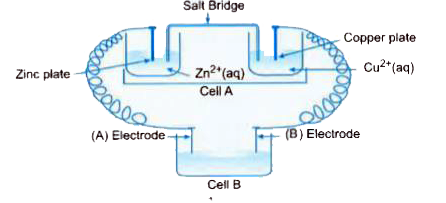
(i) Cell 'A' has Ecell=2V and Cell 'B' has Ecell=1.1V which of the two cells 'A' or 'B' will act as an electrolytic cell. Which electrode reaction will occur in this cell?
(ii) If cell 'A' has Ecell=0.5V and cell 'B' has Ecell=1.1V then what will be the reaction at anode and cathode? View SolutionQuestion 176
The following chemical reaction is occurring in an electrochemical cell
Mg(s)+2Ag+(0.0001M)→Mg2+(0.10M)+2Ag(s)
The E° electrode values are
Mg2+/Mg=−2.36V,
Ag+/Ag=0.81V
For lids cell calculate/write
(a) (i) E° value for the electrode 2Ag+/2Ag
(ii) Standard cell potential E∘cell
(b) Cell potential Ecell ,
(c) (i) Symbolic representation of the above cell.
(ii) Will the above cell reaction be spontaneous ?View SolutionQuestion 177
(a) A current of 1.50 amp was passed through an electrolytic cell containing AgNO3 solution with inert electrodes. The weight of Ag deposited was 1.50 g. How long did the current flow ?
(b) Write the reactions taking place at the anode and cathode in the above cell.
(c) Give reactions taking place at the two electrodes if these are made up of Ag.View SolutionQuestion 180
a) Calculate the charge in coulombs required for the oxidation of 2 moles of water to oxygen ? [Given 1 F = 96500 C mol−1 ]
(b) Zinc/Silver oxide cell is used in hearing aids and watches. The following reactions occur :
Zn(s)→Zn2+(aq)+2e−,E∘Zn2+/Zn=−0.76V
Ag2O+H2O+2e−→2Ag+OH−,E∘Ag+/Ag=0.344V
Calculate (i) Standard potential of the cell, (ii) Gibb's free energy: View SolutionQuestion 182
(i) Solutions of two electrolytes 'A' and 'B' are diluted. The limiting molar conductivity of 'B' increases 1.5 times while that of 'A' increases 25 times. Which of the two is a strong electrolyte ? Justify your answer.
(ii) The products of electrolysis of aqueous NaCl at the respective electrodes are :
Cathode: H2
Anode : Cl2 and not O2 . Explain.View SolutionQuestion 184
(a) Write the cell reaction and calculate the emf of the following cell at 298 K :
Sn(s)∣∣Sn2+(0.004M)∣∣∣∣H+(0.020M)∣∣H2(g)(1¯)∣Pt(s)
[Given : E∘Sn2+/Sn=−0.14V]
(b) Give reasons :
(i) On the basis of E° values, O2 gas should be liberated at anode but it is Cl2 gas which is liberated in the electrolysis of aqueous NaCl.
(ii) Conductivity of CH3COOH decreases on dilution.View SolutionQuestion 185
(a) Calcualte E∘cell for the following reaction at 298 K
2Al(s)+3Cu2+(0.01M)→2Al3+(0.01M)+3Cu(s)
Given: Ecell=1.98V
(b) Using the E∘ values of A and B predict which is better for coating the surface of iron [E∘Fe2+/Fe=−0.44V] to prevent corrosion and why?
Given: E∘A2+/A=−2.37V:E∘B2+/B=−0.14V View SolutionQuestion 186
(a) The conductivity of 0.001 mol L−1 solution of CH3COOH is 3.905×10−5Scm−1. Calculate its molar conductivity and degree of dissociation (α). Givenλ∘(H+)=349.6Scm2mol−1 and λ∘(CH3COO−)=40.9Scm2mol−1 .
(b) Define electrochemical cell. What happens if external potential applied becomes greater than E∘cell of electrochemical cell ?View SolutionQuestion 187
(a) The conductivity of 0.001 mol L−1 solution of CH3COOH is 3.905×10−5Scm−1. Calculate its molar conductivity and degree of dissociation (α).
Given :λ∘(H+)=349.6Scm2mol−1 and λ∘(CH3COO−)=40.9Scm2mol−1
(b) What type of battery is lead storage battery ? Write the overall reaction occurring in lead storage battery.View SolutionQuestion 188
(a) Calculate ΔG∘ and log Kc for the following reaction at 298 K :
2Cr(s)+3Fe2+(aq)→2Cr3+(aq)+3Fe(s)
(b) (b) Using the E° values of A and B, predict which is better for coating the surface of iron [E∘(Fe2+/Fe)=−0.44V] to prevent corrosion and why?
Given : E∘A2+/A=−2.37V:E∘B2+/B=−0.14V View SolutionQuestion 189
(a) Define molar conductivity of a solution and explain how molar conductivity changes with change in concentration of solution for a weak and a strong electrolyte.
(b) The resistance of a conductivity cell containing 0.001 M KCl solution at 298 K is 1500Ω. What is the cell constant if the conductivity of 0.001 M KCl solution at 298 K is 0.146×10−3Scm−1? View SolutionQuestion 190
What type of a battery is the lead storage battery 7 Write the anode and the cathode reactions and the overall reaction occurring in a lead storage battery when current is drawn from it.
(b) In the button cell, widely used in watches, the following reaction takes place :
Zn(s)+Ag2O(s)+H2O(l)→Zn2+(aq)+2Ag(s)+2OH−(aq)
Determine E∘ and ΔG∘ for the reaction.
[Given: E∘Ag+/Ag=+0.80V,E∘Zn2+/Zn=−0.76V] View SolutionQuestion 191
(i) What type of a battery is lead storage battery ? Write the anode and cathode reactions and the overall cell reaction occurring in the operation of a lead storage battery. (ii) Calculate the potential for half-cell containing:
0.10 M K2Cr2O7(aq),0.20MCr3+(aq) and 1.0×10−4MH+ (aq)
The half-cell reaction is:
Cr2O2−7(aq)+14H+(aq)+6e−→2Cr3+(aq)+7H2O(l)
and the standard electrode potential is given as E∘=1.33V. View SolutionQuestion 192
(a) State Kohlrausch law of independent migration of ions. Write an expression for the molar conductivity of acetic acid at infinite dilution according to Kohlrausch law.
(b) Calculate Λ∘m , for acetic acid.
Given that Λ∘m(HCl)=426Scm2mol−1
Λ∘m(NaCl)=126Scm2mol−1
Λ∘m(CH3COONa)=91Scm2mol−1 View SolutionQuestion 193
(a) Two electrolytic cells containing silver nitrate solution and dilute sulphuric acid solution were connected in series. A steady current of 2.5 amp was passed through them till 1.078 g of silver was deposited. [Ag = 107.8 g mol−1, 1 F = 96,500 C]
(i) How much electricity was consumed ?
(ii) What was the weight of oxygen gas liberated ?
(b) Give reason :
(i) Rusting of iron pipe can be prevented by joining it with a piece of magnesium.
(ii) Conductivity of an electrolyte solution decreases with the decrease in concentration.View SolutionQuestion 194
Define molar conductivity of a substance and describe how for weak and strong electrolytes, molar conductivity changes with concentration of solute. How is such change explained ? A voltaic cell is set up at 25 °C with the following half-cells :
Ag+(0.001M)∣Ag and Cu2+(0.10M)∣Cu
What would be the voltage of this cell ? [E∘cell = 0.46 V]
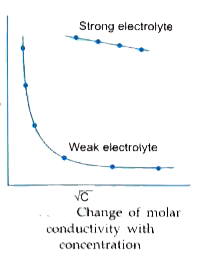 View Solution
View SolutionQuestion 195
(i) The resistance of a conductivity cell containing 0.001 M KCl solution at 298 K is 1500 Ω. What is the cell constant, if the conductivity of 0.001 M KCl solution at 298 K is 0.146×10−3Scm−1 ?
(ii) Predict the products of electrolysis in the following
A solution of H2SO4 with platinum electrodes. View SolutionQuestion 196
Consider the figure given alongside and answer the questions (i) to (vi) given below
(i) Give the direction of electron flow.
(ii) Is silver plate the anode or cathode ?
(iii) What will happen if salt bridge is removed ?
(iv) When will the cell stop functioning ? Zinc plate ,,
(v) How will concentration of Zn2+ ions and Ag+ ions be affected when the cell functions ?
(vi) How will the concentration of Zn2+ ions and Ag+ ions be affected after the cell becomes 'dead' ?
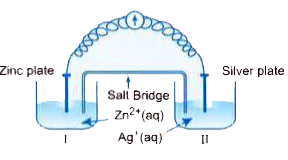 View Solution
View SolutionQuestion 197
(a) Calculate the equilibrium constant for the reaction :
Cd2+(aq)+Zn(s)<⇒Zn2+(aq)+Cd(s)
If E∘Cd2+/Cd=−0.403V,E∘Zn2+/Zn=−0.763 V
(b) When a current of 0.75 A is passed through a CuSO4 solution for 25 minutes, 0.369 g of copper is deposited at the cathode. Calculate the atomic mass of copper.
(c) Tarnished silver contains Ag2S. Can this tarnish be removed by placing tarnished silverware in an aluminium pan containing an inert electrolytic solution such as NaCl. The standard electrode potential for half reaction.
Ag2S+2e−→2Ag(s)+S2− is −0.71V and for Al3++3e−→Al(s) is −1.66 V View SolutionQuestion 198
(i) State the relationship amongst cell constant of a cell, resistance of the solution in the cell and conductivity of the solution. How is molar conductivity of a solution related to conductivity of its solution ?
(ii) A voltaic cell is set up at 25 °C with the following half cell,
Al/Al3+(0.001M) and Ni/Ni2+(0.50M)
Calcualte the cell voltage: [E∘ni2+/Ni=−0.25V,E∘Al+/Al=−1.66V] View Solution
All Exercises from U-LIKE CHEMISTRY (HINGLISH) Class 12 CHEMISTRY ELECTROCHEMISTRY
- NCERT INTEXT QUESTIONS
- NCERT TEXTBOOK EXERCISES
- CASE BASED/SOURCE-BASED INTEGRATED QUESTIONS
- CASE BASED/SOURCE-BASED INTEGRATED QUESTIONS (ASSERTION-REASON QUESTIONS )
- CASE BASED/SOURCE-BASED INTEGRATED QUESTIONS (FILL IN THE BLANKS)
- CASE BASED/SOURCE-BASED INTEGRATED QUESTIONS (LONG ANSWER QUESTIONS-I (3 MARKS EACH))
- CASE BASED/SOURCE-BASED INTEGRATED QUESTIONS (LONG ANSWER QUESTIONS-II (5 MARKS EACH))
- CASE BASED/SOURCE-BASED INTEGRATED QUESTIONS (MULTIPLE CHOICE QUESTIONS )
- CASE BASED/SOURCE-BASED INTEGRATED QUESTIONS (SHORT ANSWER QUESTIONS (2 MARKS EACH))
- CASE BASED/SOURCE-BASED INTEGRATED QUESTIONS (TRUE OR FALSE )
- CASE BASED/SOURCE-BASED INTEGRATED QUESTIONS (VERY SHORT ANSWER QUESTIONS (1 MARK EACH))
- SELF ASSESSMENT TEST (SECTION A) MULTIPLE CHOICE QUESTIONS (CHOOSE THE CORRECT OPTION)
- SELF ASSESSMENT TEST (SECTION A)VERY SHORT ANSWER QUESTIONS
- SELF ASSESSMENT TEST (SECTION B)
- SELF ASSESSMENT TEST (SECTION C)
- SELF ASSESSMENT TEST (SECTION D)
